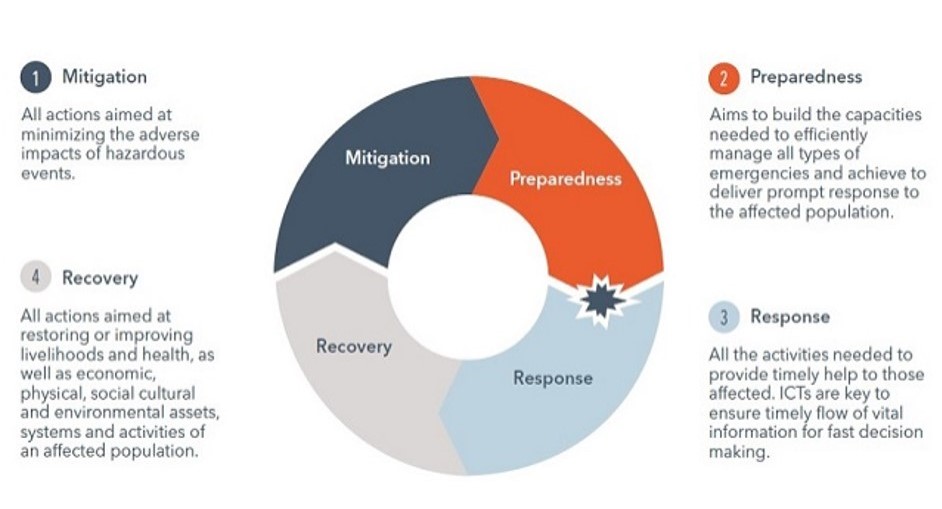National Emergency Telecommunication Plans are vital to enhance the use Information and communication technologies throughout the Disaster Management Cycle.

Including Information and Communication Technologies (ICTs) in the mitigation, preparedness, response, and recovery phases of disaster management can significantly enhance the effectiveness and efficiency of these processes. Below is an outline of some actions associated with ICT integration in each phase:
1.Mitigation
In this phase, the goal is to reduce or eliminate the risks and impacts of disasters. ICTs can play a crucial role in identifying hazards, modelling scenarios, developing risk and vulnerability maps and implementing risk-reduction strategies by integrating, among others, the following:
- Risk Assessment and Early Warning Systems (EWS): Use ICT tools to collect, analyze, and share data on potential risks such as meteorological, geological or man-made. Early warning systems can provide timely alerts to mitigate potential disaster impacts and save lives and livelihoods.
- Data Mapping and Modeling: Utilize geographic information systems (GIS) and new technologies such as AI and other tools to map vulnerable areas and model potential disaster scenarios, helping authorities prioritize mitigation efforts.
- Public Awareness an Education Campaigns: ICT platforms, such as websites, social media, mobile apps, can be used to educate communities about natural hazards, disaster risks and prevention measures, improving public awareness.
- Stakeholder involvement: Plays a crucial role in disaster management. Agencies from national and local governments (Ministry of ICTs, Regulator, Disaster Management Organizations, etc), humanitarian organizations (national Red Cross, Fire-fighters, Civil Society, UN, NGOs, etc), private sector (MNOs, satellite providers, internet services, etc), technical institutions (Meteorological, hydrological, geological agencies, etc) public security, among others, should be part of the development of NETPs.
- Policies, Legislations and Regulations: Policies that mandate the development of reliable ICT infrastructure, laws that set priorities for the restoration of communication services during and after a disaster, regulatory frameworks and standards to allow the use of telecommunications (mobile networks, satellite, radio equipment, etc) in times of crises.
2. Preparedness
In this phase, ICTs help ensure that countries and communities are ready to act in the event of a disaster by implementing among others, the following aspects:
- Training and Simulation: Exercises that are conducted to test and refine national plans, policies, and regulatory frameworks, as well as to ensure that ICT networks, redundant communication capacities, personnel, and other telecommunication systems are in place and ready for disaster response.
- Capacity building: Ensuring that governments, organizations, communities, and individuals are prepared to effectively use ICTs in disaster management. This involves enhancing the skills, knowledge, and resources necessary to deploy and manage ICT tools and systems during disaster situations.
- Communication Networks: Establish and maintain robust communication networks that ensure connectivity during a crisis. This includes mobile networks, satellite systems, and internet connectivity for all stakeholders involved in disaster management.
- Testing Early Warning Systems: To ensure that all systems are in good conditions, that alerts are disseminated, messages are understood, and actions are taken. This includes community involvement.
3. Response
During this phase, ICTs enable rapid and effective coordination and action to save lives and prioritize response by:
- Real-Time Communication and Coordination: ICT tools like the Disaster Connectivity Map, satellite communication, and social media allow for real-time communication between disaster response teams, government agencies, and affected populations.
- Information Sharing: ICTs enable efficient data sharing across various agencies, allowing for faster decision-making. For instance, real-time geographic information (ex. from drones or satellite imagery) can help pinpoint affected areas and assess damage.
- Crowdsourcing: Mobile apps and social media can be used to collect real-time information from citizens about the situation on the ground, helping authorities allocate resources where they are most needed.
- Telemedicine: ICT tools like telemedicine platforms can provide remote medical consultations to disaster-affected populations when healthcare facilities are overwhelmed.
4. Recovery
Throughout this phase, ICTs support the process of rebuilding back better by:
- Damage Assessment and Resource Allocation: ICT tools like GIS, drones, and satellite imagery help assess the extent of damage and identify areas needing immediate attention. This data can be used to prioritize recovery efforts and allocate resources effectively.
- Rebuilding Infrastructure: ICTs are crucial in rebuilding communications infrastructure, including restoring internet connectivity, mobile networks, and electricity grids, which are essential for the long-term recovery of affected regions.
- Monitoring and Evaluation: ICT tools can be used for monitoring recovery progress, tracking the distribution of aid, and evaluating the effectiveness of recovery strategies.
By integrating ICTs across all phases of disaster management, countries can enhance their resilience and capacity to respond more effectively to disasters, reduce vulnerability and risks, and accelerate recovery efforts.